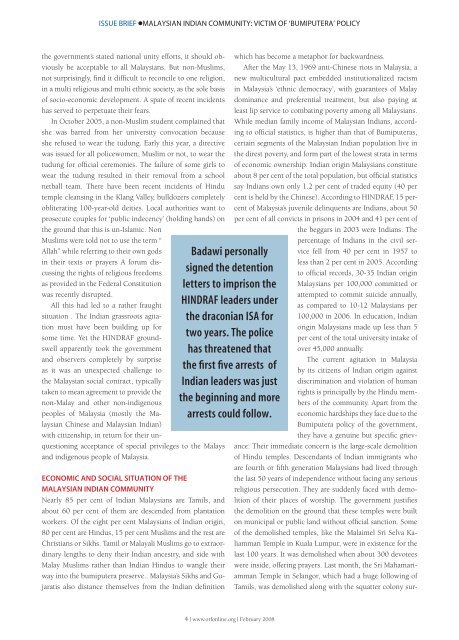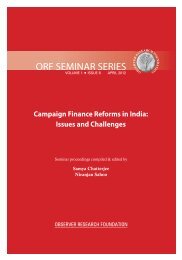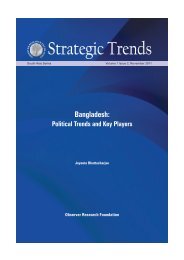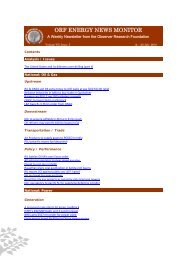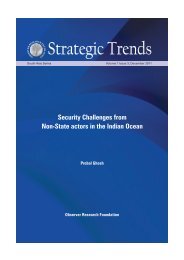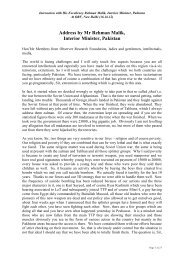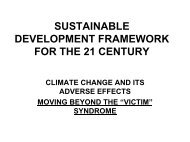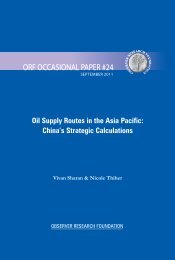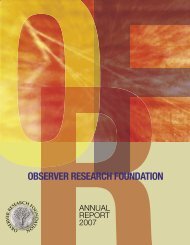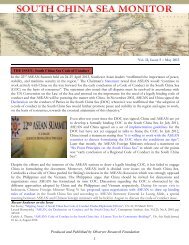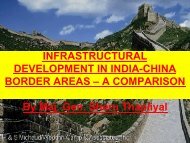Malaysian Indian Community: Victim of 'Bumiputera' Policy
Malaysian Indian Community: Victim of 'Bumiputera' Policy
Malaysian Indian Community: Victim of 'Bumiputera' Policy
Create successful ePaper yourself
Turn your PDF publications into a flip-book with our unique Google optimized e-Paper software.
ISSUE BRIEF ●MALAYSIAN INDIAN COMMUNITY: VICTIM OF ‘BUMIPUTERA’ POLICY<br />
the government’s stated national unity efforts, it should obviously<br />
be acceptable to all <strong>Malaysian</strong>s. But non-Muslims,<br />
not surprisingly, find it difficult to reconcile to one religion,<br />
in a multi religious and multi ethnic society, as the sole basis<br />
<strong>of</strong> socio-economic development. A spate <strong>of</strong> recent incidents<br />
has served to perpetuate their fears.<br />
In October 2005, a non-Muslim student complained that<br />
she was barred from her university convocation because<br />
she refused to wear the tudung. Early this year, a directive<br />
was issued for all policewomen, Muslim or not, to wear the<br />
tudung for <strong>of</strong>ficial ceremonies. The failure <strong>of</strong> some girls to<br />
wear the tudung resulted in their removal from a school<br />
netball team. There have been recent incidents <strong>of</strong> Hindu<br />
temple cleansing in the Klang Valley, bulldozers completely<br />
obliterating 100-year-old deities. Local authorities want to<br />
prosecute couples for ‘public indecency’ (holding hands) on<br />
the ground that this is un-Islamic. Non<br />
Muslims were told not to use the term “<br />
Allah” while referring to their own gods<br />
in their texts or prayers A forum discussing<br />
the rights <strong>of</strong> religious freedoms<br />
as provided in the Federal Constitution<br />
was recently disrupted.<br />
All this had led to a rather fraught<br />
situation . The <strong>Indian</strong> grassroots agitation<br />
must have been building up for<br />
some time. Yet the HINDRAF groundswell<br />
apparently took the government<br />
and observers completely by surprise<br />
as it was an unexpected challenge to<br />
the <strong>Malaysian</strong> social contract, typically<br />
taken to mean agreement to provide the<br />
non-Malay and other non-indigenous<br />
peoples <strong>of</strong> Malaysia (mostly the <strong>Malaysian</strong><br />
Chinese and <strong>Malaysian</strong> <strong>Indian</strong>)<br />
with citizenship, in return for their unquestioning<br />
acceptance <strong>of</strong> special privileges to the Malays<br />
and indigenous people <strong>of</strong> Malaysia.<br />
ECONOMIC AND SOCIAL SITUATION OF THE<br />
MALAYSIAN INDIAN COMMUNITY<br />
Nearly 85 per cent <strong>of</strong> <strong>Indian</strong> <strong>Malaysian</strong>s are Tamils, and<br />
about 60 per cent <strong>of</strong> them are descended from plantation<br />
workers. Of the eight per cent <strong>Malaysian</strong>s <strong>of</strong> <strong>Indian</strong> origin,<br />
80 per cent are Hindus, 15 per cent Muslims and the rest are<br />
Christians or Sikhs. Tamil or Malayali Muslims go to extraordinary<br />
lengths to deny their <strong>Indian</strong> ancestry, and side with<br />
Malay Muslims rather than <strong>Indian</strong> Hindus to wangle their<br />
way into the bumiputera preserve.. Malaysia’s Sikhs and Gujaratis<br />
also distance themselves from the <strong>Indian</strong> definition<br />
Badawi personally<br />
signed the detention<br />
letters to imprison the<br />
HINDRAF leaders under<br />
the draconian ISA for<br />
two years. The police<br />
has threatened that<br />
the first five arrests <strong>of</strong><br />
<strong>Indian</strong> leaders was just<br />
the beginning and more<br />
arrests could follow.<br />
which has become a metaphor for backwardness.<br />
After the May 13, 1969 anti-Chinese riots in Malaysia, a<br />
new multicultural pact embedded institutionalized racism<br />
in Malaysia’s ‘ethnic democracy’, with guarantees <strong>of</strong> Malay<br />
dominance and preferential treatment, but also paying at<br />
least lip service to combating poverty among all <strong>Malaysian</strong>s.<br />
While median family income <strong>of</strong> <strong>Malaysian</strong> <strong>Indian</strong>s, according<br />
to <strong>of</strong>ficial statistics, is higher than that <strong>of</strong> Bumiputeras,<br />
certain segments <strong>of</strong> the <strong>Malaysian</strong> <strong>Indian</strong> population live in<br />
the direst poverty, and form part <strong>of</strong> the lowest strata in terms<br />
<strong>of</strong> economic ownership. <strong>Indian</strong> origin <strong>Malaysian</strong>s constitute<br />
about 8 per cent <strong>of</strong> the total population, but <strong>of</strong>ficial statistics<br />
say <strong>Indian</strong>s own only 1.2 per cent <strong>of</strong> traded equity (40 per<br />
cent is held by the Chinese). According to HINDRAF, 15 percent<br />
<strong>of</strong> Malaysia’s juvenile delinquents are <strong>Indian</strong>s, about 50<br />
per cent <strong>of</strong> all convicts in prisons in 2004 and 41 per cent <strong>of</strong><br />
the beggars in 2003 were <strong>Indian</strong>s. The<br />
percentage <strong>of</strong> <strong>Indian</strong>s in the civil service<br />
fell from 40 per cent in 1957 to<br />
less than 2 per cent in 2005. According<br />
to <strong>of</strong>ficial records, 30-35 <strong>Indian</strong> origin<br />
<strong>Malaysian</strong>s per 100,000 committed or<br />
attempted to commit suicide annually,<br />
as compared to 10-12 <strong>Malaysian</strong>s per<br />
100,000 in 2006. In education, <strong>Indian</strong><br />
origin <strong>Malaysian</strong>s made up less than 5<br />
per cent <strong>of</strong> the total university intake <strong>of</strong><br />
over 45,000 annually.<br />
The current agitation in Malaysia<br />
by its citizens <strong>of</strong> <strong>Indian</strong> origin against<br />
discrimination and violation <strong>of</strong> human<br />
rights is principally by the Hindu members<br />
<strong>of</strong> the community. Apart from the<br />
economic hardships they face due to the<br />
Bumiputera policy <strong>of</strong> the government,<br />
they have a genuine but specific grievance:<br />
Their immediate concern is the large-scale demolition<br />
<strong>of</strong> Hindu temples. Descendants <strong>of</strong> <strong>Indian</strong> immigrants who<br />
are fourth or fifth generation <strong>Malaysian</strong>s had lived through<br />
the last 50 years <strong>of</strong> independence without facing any serious<br />
religious persecution. They are suddenly faced with demolition<br />
<strong>of</strong> their places <strong>of</strong> worship. The government justifies<br />
the demolition on the ground that these temples were built<br />
on municipal or public land without <strong>of</strong>ficial sanction. Some<br />
<strong>of</strong> the demolished temples, like the Malaimel Sri Selva Kaliamman<br />
Temple in Kuala Lumpur, were in existence for the<br />
last 100 years. It was demolished when about 300 devotees<br />
were inside, <strong>of</strong>fering prayers. Last month, the Sri Mahamariamman<br />
Temple in Selangor, which had a huge following <strong>of</strong><br />
Tamils, was demolished along with the squatter colony sur-<br />
4 | www.orfonline.org | February 2008


